Even after publishing great content, do you find that other websites still outrank your website in search results?
Don’t despair! Peeking into what those higher-ranking competitors are doing can help you turn the table and start outranking them. This is what SEO competitor analysis is all about!
But how do you carry out an SEO competitor analysis?
This SEO competitor analysis guide will examine these steps in detail. You will learn how to outrank your competitors and attract more organic traffic to your website.
Overview of SEO competitive analysis
SEO competitive analysis (also known as SEO competitor analysis) helps you assess your competitors by studying their SEO strategies to glean insights into improving your own.
If your competitors’ websites are consistently ranking higher than yours on search engine result pages, there must be things they’re doing that you aren’t. Finding out what those things are and incorporating them into your search engine optimisation strategy can help you start outranking them.
Thus, researching your search competitor provides a wealth of information for improving your SEO strategy. The analysis can reveal relevant keywords, content ideas, and link-building opportunities you may not have considered.
The insights from SEO competitor analysis can help you:
- Uncover your competitors’ winning strategies and implement them to create a more effective SEO strategy for your website.
- Uncover your competitors’ weaknesses and capitalise on them to strengthen your own SEO efforts.
Also read: SEO Optimisation: How to Optimise for SEO.
How to identify your SEO competitors
Before you can analyse your SEO competitors to uncover their winning strategies, you must know who these competitors are. So, the first step in SEO competitive analysis is identifying your competitors.
Your SEO competitors (or search competitors) are websites that rank high on page one of Google (or other search engines) for the organic search queries you are competing for.
These websites compete for the same target audience as you, as they target the same keywords you are. However, they may be different from your direct business competitors.
For example, Sonoma State University is the #1 ranking website for the “How to create email templates” keyphrase, but it is not a direct business competitor of any email template creation tool.
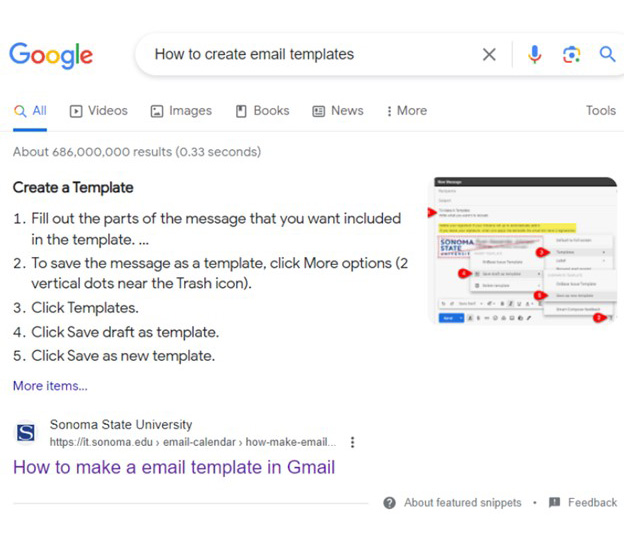
Here are the things you should do to identify your competitors:
Search for your organic competitors
There are different ways to identify your search competitors, including manually searching for them or using a dedicated SEO tool.
A manual search is the easiest way to identify your competitors. This involves searching your main keywords on Google (or another search engine) and taking note of the domains in the top positions.
For example, when targeting the keyword “Purple Shoes,” search the phrase and review all the domains that appear for it.
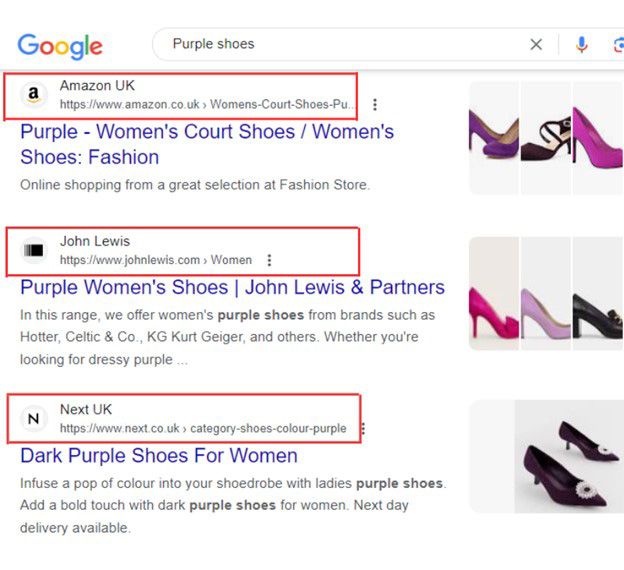
The manual method works fine if you’re trying to rank for a few keywords. But if you’re targeting many keywords, you’ll be better served with a dedicated resource like Semrush.
Semrush is a software that companies use to run digital marketing strategies. You can use it for keyword research, competitive analysis, SEO audits, and more.
Finding your search competitors using Semrush is easy.
After logging in with your details, click “Domain Overview” on the right-hand pane. Enter your URL in the field and hit the “Search.”
Then, scroll down the page to the “Main Organic Competitors” section to find the SEO competitor of the domain you entered.
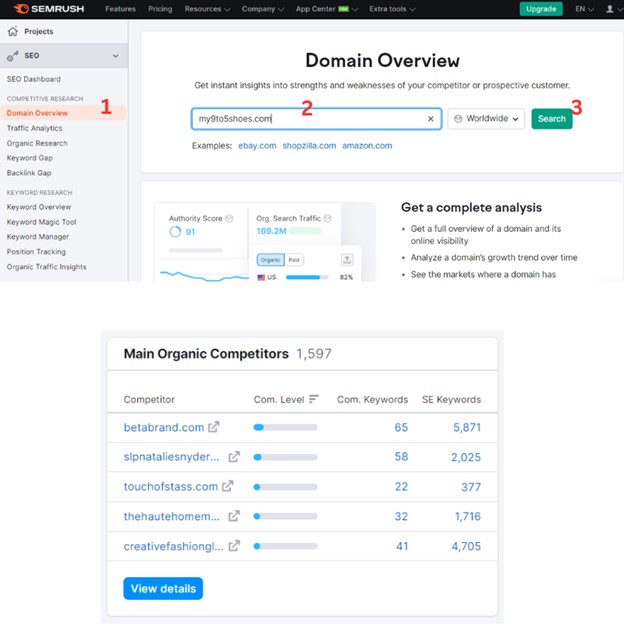
In the example above, we use Semrush to search for the competitors of the “my9to5shoes” domain. Clicking the “view details” button in the “Main Organic Competitors” window will show you a complete list of competitors and other valuable info.
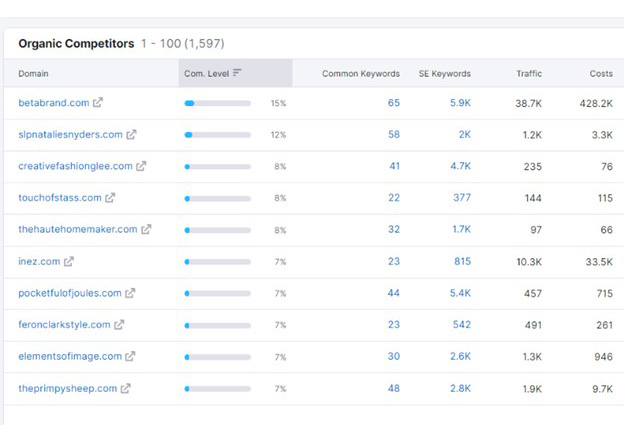
Check the Authority Score of your competitors
The Authority Score (AS) is a metric representing the overall quality of a website. The Authority Score of websites shows how authoritative Google or other search engines view them. Incorporating effective link-building strategies, such as integrating high-quality links from acclaimed websites in your niche, can boost your domain authority.
Given that Google only shows sites it perceives as high-quality in its search results, websites with high Authority Scores are hard to compete against.
For example, if you are a small shoe-selling website, you’ll probably struggle to outrank websites like Amazon, Nordstrom, and other bigshots.
Checking Authority Score helps you identify where you stand among your SEO competitors in order to determine which sites you can realistically compete against.
Using the SEMrush tool, you’ll find your Authority Score in the Domain Overview, where you searched for your competitors.
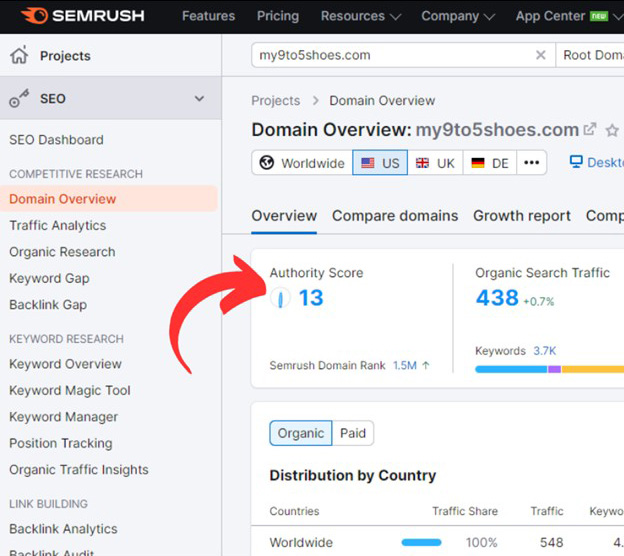
You can then search for your competitors’ AS by entering each domain into the search bar in the Domain Overview and searching. If you have several competitors, you can use SEMrush’s Bulk Analysis tool.
Click “Bulk Analysis” in the right-hand pane under the SEO tab. Enter the domain names of up to 200 competitors, then click “Compare.”
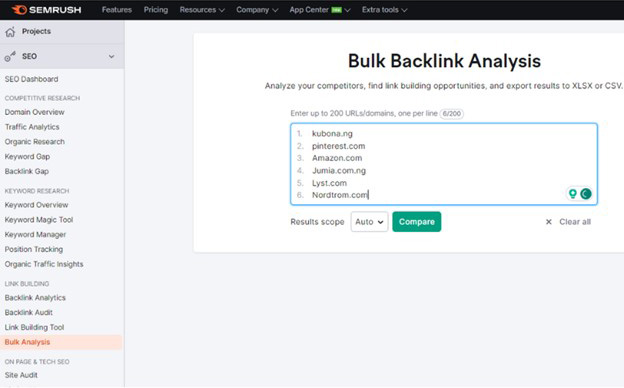
On the report page, scroll down to the “Analysed Targets” section, where you’ll find the authority score of your competitors’ domains.
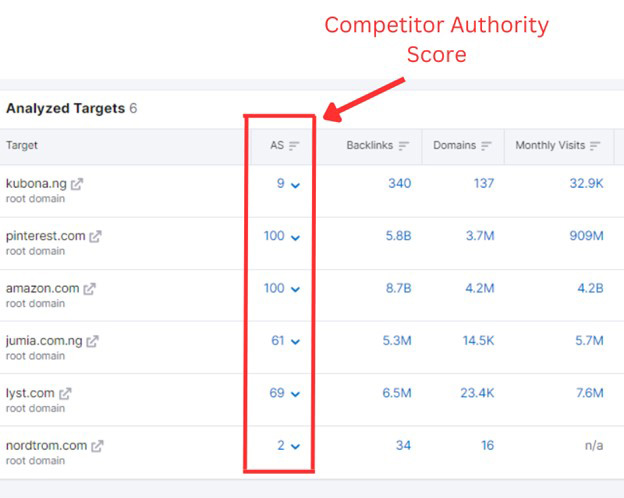
Semrush is one of many tools that can be used to analyse the offsite profile of your competitors. Amongst them are Ahref, Majestic SEO and Moz
You may also like: What is Domain Authority in SEO?
Decide who not to compete against
Your manual or SEMrush competitor search will populate several domains that are outranking you. You do not need to try to outrank every one of them. So, after identifying your search competitors, the next step is deciding who not to compete against.
Note that not every domain identified in your manual or SEMrush competitor search will be your true competitor. For example, in the manual search for competitors ranking for the keyphrase “Purple Shoes,” Pinterest and Amazon are on the list.
While Pinterest may be competing for the “Purple Shoes” keyword, it is not a true competitor of a shoe-selling business as it does not sell shoes.
So, review the list of competitors and identify your true competitors. These will be websites that offer products/ services similar to yours or those in the same niche as yours and serve the same audience.
Also, among the true competitors, you will struggle to outrank those with high Authority scores. Amazon is famously hard to outrank because of its massive offer as well as its authority. To compete with their pages, your website needs to be in pristine technical condition, have excellent authority and an ironclad SEO strategy. It’s not impossible, but it can be unrealistic (and discouraging) to set objectives that are unattainable. So, choosing the right competitors to focus on is all the more important: it will enable you to climb the ladder at the right pace for your business.
How to perform a competitive keyword analysis
Performing a competitive keyword analysis means determining the keywords that are helping your SEO competitors rank in the top spots of search engine results.
A keyword competitor analysis will help you target the right keywords in order to rank higher in search engines.
Steps for performing competitor keyword analysis include:
Keyword gap analysis
Gaps in keyword analysis are specific keywords your competitors are ranking for that you aren’t.
Each keyword gap is a big opportunity to move up the search engine rankings. Identify the keyword gaps that are relevant to your business, then use them to create more valuable content. You may:
- Add the keywords to existing content.
- Create new content featuring the identified keyword.
Performing keyword gap analysis is easy with SEMrush’s Keyword Gap tool.
Click “Keyword Gap” in the right-hand pane under the SEO tab. Enter your URL and the URLs of your four main competitors. Then hit the “Compare” button.
On the result page, scroll down to the “Top Opportunities” section. This lists the missing keywords (keywords your competitors are ranking for, but you aren’t) and their search volume.
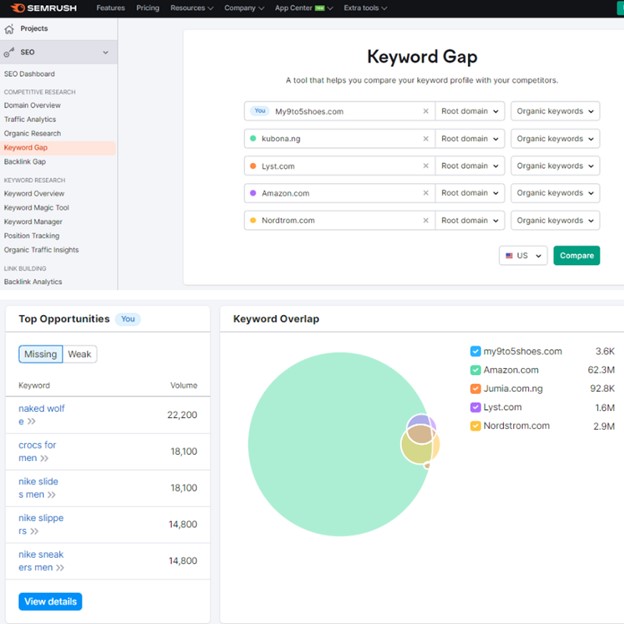
Review the keywords and select those that are relevant to your business to target.
New keywords ranking
Just as it’s important to keep a close eye on the keywords your competitors are using to rank, it’s also important to pay attention to new keywords they are targeting.
Keywords are not set in stone in the world of search engine optimisation. Smart businesses keep an eye on the “keywords of the moment” and jump on them (by creating content that features these keywords) to improve their SEO rankings.
Identifying the new niche keywords that your competitors are targeting gives you ideas about the kind of content you should create to improve rankings.
Analysing competitors’ new keywords is easy using SEMrush’s Organic Research tool.
- Under the SEO tab, click “Organic Research.”
- In the window that opens, enter your URL and the URLs of your main competitors, then hit “Compare.”
- In the results page, navigate to the “Position Changes” tab, and filter the results to show only new keywords.
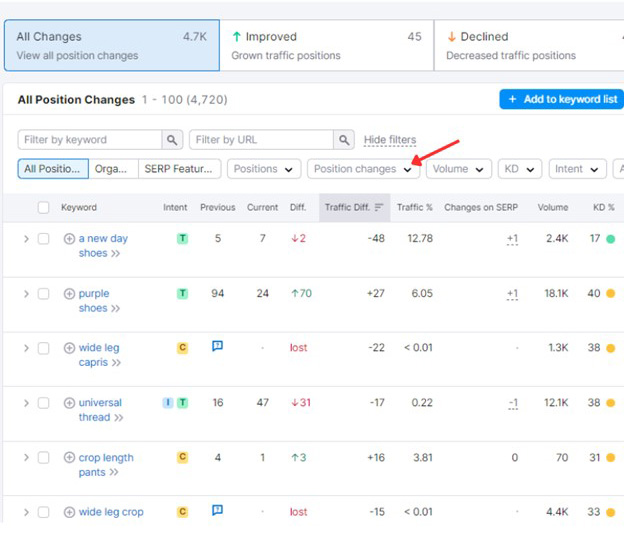
Analyse each keyword in the list individually, and determine the type of content you need to create to target these keywords.
Don’t limit yourself to only keywords your competitors rank for in organic search. Also, look at the keywords they bid on in paid search. If they can bid for specific keywords, then they must be valuable.
Lost keywords ranking
Websites lose keyword rankings all the time. It can result from site changes, Google algorithm updates, etc.
However, whatever the reason, when your competitors are no longer ranking for keywords they used to rank for, their loss can be your gain, especially if the keywords are still driving traffic.
You can use SEMrush’s Organic Research tool to find your competitors’ lost keywords. Here is what you should do:
- Enter the URL of your competitor in the Organic Research window, then click “Compare.”
- Navigate to the “Position Changes” tab, then select “Lost” from the position drop-down menu to filter the result to show only lost keywords.
- Lastly, review each of the identified keywords to know which ones you can target to improve your ranking.
How to analyse the content of your competitor
Reviewing your competitors’ content can help you understand why they outrank you in search engines. The analysis will show you what makes your competitors’ content good.
For example, you’ll see the kind of content they create and how they incorporate keywords into their pages. You’ll also see gaps in their content that you can fill to create more valuable information.
Specific steps to analyse competitors’ content include:
Content type analysis
A good place to start analysing your competitor’s content is by looking at the different types of content they publish.
Have they included SEO content on their main category pages listing products? Are there FAQ sections for the services pages? How is the text displayed?
Do they publish infographics, listicles, how-to guides, or detailed guides in their blog? Are they making podcasts or videos?
Examine the kind of content they publish and the traction that each content type gets.
The content in their top-ranking pages will give you inspiration. For example, if your competitors are having success with detailed guides, you may develop more detailed, informative content that satisfies the user’s search intent.
Semrush’s “Pages” report can help you analyse your competitors’ pages.
Meta titles
The meta title is the name of articles as they appear on search engine result pages.
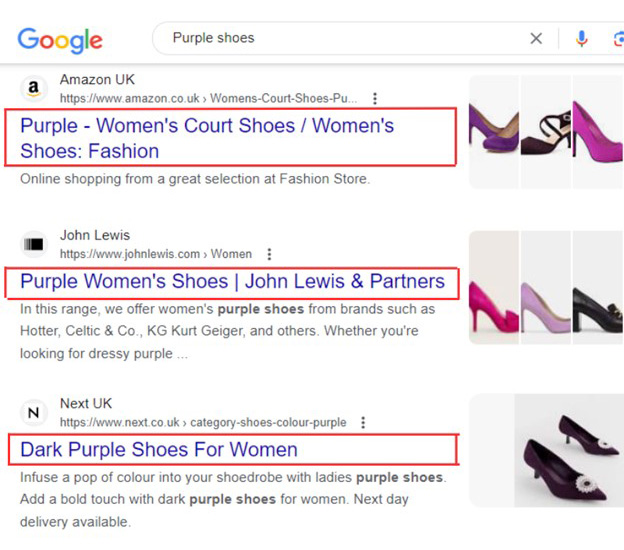
Analyse the meta titles (title tags) of your competitors’ content that outranks you. Pay attention to how they incorporate keywords into their meta titles. For example, do the keywords appear near the beginning or the end of the title?
This will give you ideas on how to craft compelling titles for your content.
Meta description
The meta description is the short description of the content that appears underneath the title in SERPs. While meta descriptions are not ranking factors, they drive clicks and should be used as a marketing tool to bring forward the main benefits to persuade the user to click.
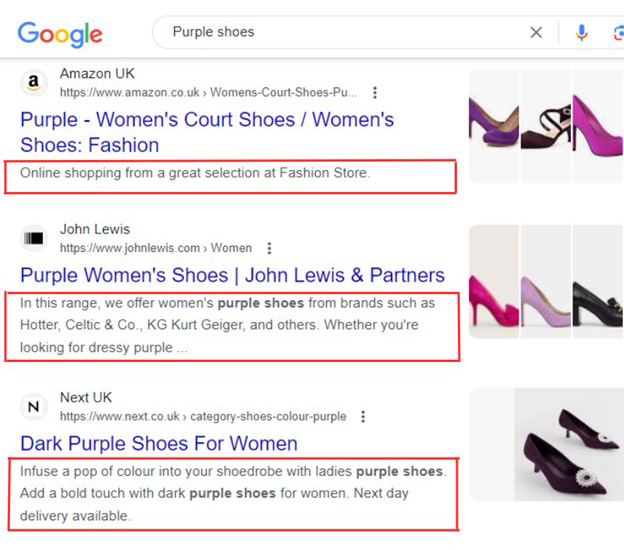
So, analyse your competitors’ meta descriptions to see if you can draw inspiration from them to optimise yours. Examine how descriptive the meta description is, the position of target keywords, the use of numbers, etc. Use the meta description to bring forward the key unique selling points such as delivery time or payment facilities, as well as reassuring elements (reviews for example).
Header tags
Header tags (H1, H2, H3, etc.) define a web page’s structure. These tags matter in search engine optimisation because search engines use them to understand the structure and hierarchy of content.
Know that search engines prefer well-structured content, and select these for search results.
Analysing competitors’ header tags will reveal how they structure their content. You can then draw from this to structure your content effectively to make it more search-engine-friendly. When analysing competitors’ use of header tags, look at how they use H1, H2, and H3 tags and how they incorporate the target keywords into the headers.
Featured snippet
Featured snippets are short text often appearing at the top of Google’s search results to answer the query quickly.
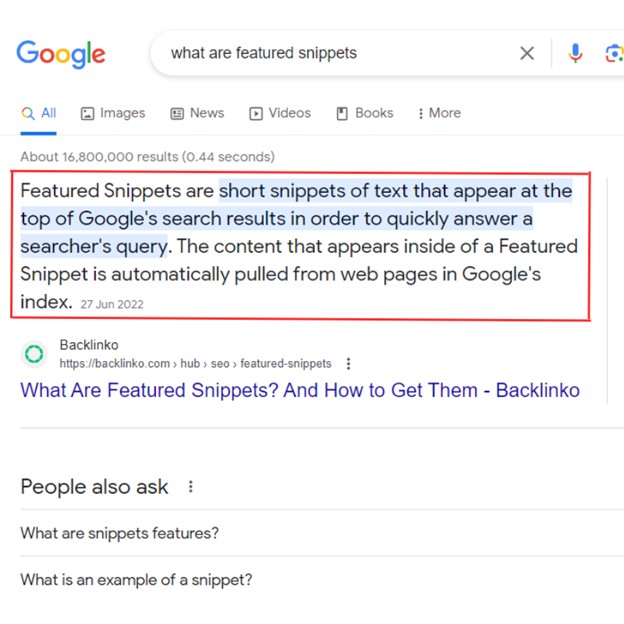
Use your target keywords in searches, as your target audiences would, and pay attention to featured snippets appearing. Look at the featured snippets to understand why Google will extract that information from your competitor’s page to feature.
You may see that the featured snippet answers the search query accurately, succinctly, and comprehensively. You may draw insight from this when creating your content to see whether you can land featured snippets.
You can use Semrush’s Organic Research tool to see the featured snippets your competitors own.
Enter your competitor’s URL on the page and click “search.” In the results, find the “SERP Features” and click “Featured Snippet.”
How to conduct a competitive backlink analysis
Backlinks are links from external websites directing users to your website. They are important ranking factors because search engines consider them a vote of confidence.
The more reputable the external website, the more ranking power your backlink gives you. Thus, competitor sites outranking you probably have backlinks from more reputable and authoritative websites.
Backlink analysis involves analysing your competitor’s backlink profile to identify the external websites linking to them. This helps you identify potential link building opportunities, as you can then arrange to acquire those high-quality backlinks.
Analysing competitors’ backlink profiles is easy with Semrush’s “Backlink Analytics” tool. Enter your URL and hit “Analyse.” Then, enter your competitor’s URL in the “Overview” section and hit “Compare.”
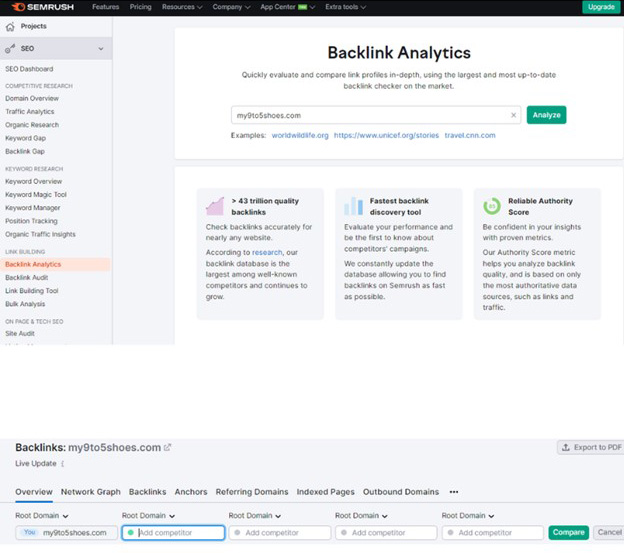
You’ll then see a table listing referring domains and total backlists for you and your competitors.
Some things to note when analysing competitors’ backlinks are:
High-quality vs. low-quality backlinks
You’ll rank higher with a few high-quality backlinks than with many low-quality backlinks.
High-quality backlinks are those from high-profile or well-established sites in your niche (or those from news sites), while low-quality backlinks are those from private blog networks, link farms, and spammy sites.
Nofollow vs. Follow backlinks
Following backlinks allows Google to pass SEO value on account of linking to your website. By contrast, Nofollow backlinks do not allow Google to pass PageRank.
You should work for Follow backlinks. However, don’t ignore high-quality backlinks because they are marked “nofollow,” as they help with referral traffic.
Backlink gap analysis
Backlink gaps are external websites that link to your competitors but do not link to you. If the backlink analysis reveals websites that link to your competitors, you can check whether they also link to you. If they do not, you can request a backlink.
Analysing deep linking strategies
Looking at the overall offsite domain profile of your competitors is important, but you should not stop there. Analyzing the SERP for your strategic keywords, you may notice that the order in which your competitors appear may change: looking backlink profile of the pages in the top 10 on a given keyword will give you information on the deep linking strategies your competitors have put in place. You can assess the number of links needed to improve your rankings, the type of anchor texts you should use, the quality of the backlinks you’d require, etc.
How to conduct a competitor analysis for technical SEO
Analysing how well your competitors have optimised their websites from a technical standpoint can help you identify technical aspects of your site you can improve to gain a competitive advantage.
Conduct a competitor website audit for technical SEO, looking at aspects like:
Site Speed
The speed of web pages is a ranking factor because it affects user experience, and search engines want to recommend only websites with great user experience.
Evaluate the loading times of your competitor’s pages and compare them with yours. If your website is slower, optimise it for speed to enhance user experience.
Site structure
Site structure is a ranking factor because a well-structured and logical website enhances user experience.
Evaluate how your competitors’ websites are organised. Pay attention to the structure of the URLs, the sites’ overall layout, categorisation in the menu section, information flow, footer section content, etc.
The analysis can give you ideas to optimise your site structure for improved user experience and SEO ranking. It could also give you insights into developing your business if you notice a service or product gap.
Also read: Website Structure: The Key to Giving Your Website Coherence and Consistency.
Mobile Optimisation
Mobile-friendliness is a ranking factor because more and more people search the web using mobile devices, and Google wants to recommend content that its users can view on their devices.

Analyse how your competitor’s site is optimised for mobile devices. Pay attention to important aspects, such as design and mobile page speed. Glean insights from the analysis to make your website mobile-friendly and responsive.
Takeaway: Perform SEO competitor analysis to improve your SEO ranking and organic traffic
Competitor analysis helps you uncover your competitors’ winning strategies so as to replicate them to strengthen your SEO efforts and boost your SEO rankings.
Performing competitor analysis starts with identifying your SEO competitors and involves aspects like competitor keyword analysis, competitor content analysis, competitor backlink analysis, and competitor technical SEO analysis.
While you can perform SEO competitive analysis following the steps outlined above, engaging a professional SEO agency will take your SEO strategies to the next level. This is where Estimoz comes in!
We’re a digital acquisition agency that crafts tailor-made strategies that generate growth. Using our expertise and experience in the digital environment, we’ll help you uncover your competitors’ winning strategies and design techniques to help you outrank them.
Contact Estimoz today and learn how we can take your SEO game to the next level!
FAQs
Here are the answers to some frequently asked questions:
How do I find SEO keywords for competitors?
You can find the SEO keywords your competitors are using to rank in the top places of SERPs using keyword research tools like Semrush.
Why is SEO competitor analysis important?
Competitor analysis is very important in SEO because it helps you know why your competitors are outranking you in search results and gives you insights (like relevant keywords, content ideas, and link-building opportunities) into improving your SEO strategy and ranking.












